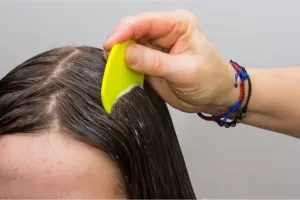How to treat Head Lice
Medically Reviewed by Dr Richard Bennett
Last updated on 11.06.2024
What are Head Lice?
Head Lice are small insects that live in human hair and feed on blood from the scalp. Outbreaks are very common in childcare centres, schools and residential facilities.
How do Head Lice spread?
Head Lice are spread by close head-to-head contact. Less commonly they can spread by sharing items such as a hairbrushes, combs or pillows. The types of lice that live on other animals do not infect humans. Head Lice do not have wings, so they crawl from place to place- they cannot fly or jump from one person to another.
Are Head Lice a sign of poor hygiene?
No. Anyone can get Head Lice! And, whilst Head Lice can cause itch and discomfort, they do not carry or spread any diseases.
How do you know if you have Head Lice?
- Some people may get an itchy scalp from Head Lice, but in more than half of cases there is no itch.
- To check for Head Lice, you can inspect the hair for eggs (also known as “nits”).
- The eggs are small whitish or beige and oval-shaped. They are usually stuck to the hair, close to the roots.
- The lice themselves may be more difficult to spot, as they tend to move quickly when disturbed – they are a pale brownish, about 2 to 4 mm long, roughly the same size and shape as a sesame seed.
Wet combing to check for Head Lice
- One of the best ways to check for Head Lice is wet combing.
- First, apply lots of hair conditioner, coating the hair from the root to the tip.
- A wide tooth comb is then used to spread the conditioner through the hair, removing any knots.
- At this point, take a quick look behind the ears and around the back of the neck, as lice may quickly move to these locations when disturbed.
- Then, with a fine toothed comb, work through the hair section by section, from root to tip, inspecting the comb regularly for lice and eggs, wiping it on a tissue as you go.
How to treat Head Lice
There are two main options- wet combing and chemical treatments:
Wet combing to treat Head Lice
This is similar to the wet combing technique used to check for Head Lice. It may be a preferred option in certain situations where chemical treatment is not suitable- e.g. in babies, pregnant women or people with sensitive skin or allergies.
- As described above, apply conditioner liberally to dry hair, covering the scalp and hair from root to tip, then untangle the hair with a wide-toothed comb.
- Draw a fine-toothed comb through each section of hair from the roots to tips, wiping the comb onto a tissue to check for lice or eggs at the end of each stroke.
- Each section of hair should be combed through at least 5 times.
- The amount of time involved will depend on how long and thick the person’s hair is.
- After combing, wash the hair as normal.
- Scrub the comb clean with an old toothbrush, to remove eggs and lice.
- If head lice are found during wet combing, the above steps should be repeated every 2 days until no lice are found for 10 days.
Chemical treatments
- Various chemical treatments are available without prescription from pharmacies.
- Some treatments are not suitable for certain groups, such as children under the age of 2, people with sensitive skin, or women who are pregnant or breastfeeding. Your pharmacist can advise you on the best option for you.
- It may be necessary to treat a second time, after a week, because eggs are not always killed by the first treatment.
- If lice are still present after a second treatment, another product should be tried, or wet combing.
If neither wet combing nor chemical treatments work, speak to a doctor- sometimes oral medication can be prescribed, in difficult cases.
Further Patient Resources

Getting a Mental Health Care Plan in Australia: Your Guide
Getting a Mental Health Care Plan in Australia: Your Guide Mental health matters—and if you’re feeling overwhelmed, anxious, or down, a mental health care plan can help. But what is it, and how do [...]
UTI Symptoms and Treatment: What You Need to Know
UTI Symptoms and Treatment: What You Need to Know Urinary Tract Infections (UTIs) are common, uncomfortable, and often disruptive. But what exactly are the signs to watch for, and how can you get relief [...]
Free Mental Health Care Plan Online | Bulk-Billed by Qoctor
Free Mental Health Care Plan Online | Bulk-Billed by Qoctor Discover how to get a free, bulk-billed Mental Health Care Plan (MHCP) in Australia through Qoctor's telehealth service. Accessing [...]





